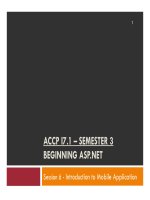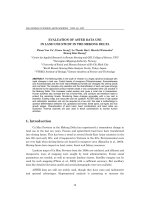Slide land evaluation
Bạn đang xem bản rút gọn của tài liệu. Xem và tải ngay bản đầy đủ của tài liệu tại đây (483.23 KB, 13 trang )
LAND EVALUATION
What is land evaluation?
The assessment of land performance when used for a specified
purpose, involving the execution and interpretation of surveys
and studies of land forms, soils, vegetation, climate and other
aspects of land in order to identify and make a comparison of
promising kinds of land use in terms applicable to the objectives
of the evaluation' (FAO, 1976)
Principles
1
Land suitability is assessed and classified with respect to
specified kinds of use
2
Evaluation requires a comparison of the benefits obtained and the
inputs needed on different types of land
3
A multidisciplinary approach is required
4
Evaluation is made in terms relevant to the physical economic and
social context of the area concerned
5
Suitability refers to use on a sustained basis
6
Evaluation involves comparison of more than a single kind of use
Land comprises the physical environment ( including climate,
relief, soils, hydrology and vegetation, to the extent that these
influence potential for land uses. It includes the results of past
and present human activity.
Land evaluation
ASSESS LAND SUITABILITY BASE ON
The requirements of specific land uses.
A comparative analysis of input Vs benefit (Multi-disciplinary)
The physical, economic and social context.
Potential environmental impact & suitability.
TWO-STAGE AND PARALLEL APPROACH TO LAND EVALUATION (FAO 1976)
Land characteristics, land qualities and diagnostic criteria
A land characteristic is an attribute of land that can be measured or estimated.
(Ex: slope angle, rainfall, soil texture, available water capacity, biomass of
the vegetation, etc. Land mapping units, as determined by resource surveys,
are normally described in terms of land characteristics.)
A land quality is a complex attribute of land which acts in a distinct manner in its
influence on the suitability of land for a specific kind of use.
(Ex: are moisture availability, erosion resistance, flooding hazard)
A diagnostic criterion is a variable which serves as a basis for assessing the suitability
of a given area of land for that use. This variable may be a land quality.
For every diagnostic criterion there will be a critical value which are used to define
suitability class limits.
Structure of the suitability classification
1. Land Suitability Orders:
reflecting kinds of suitability.
2. Land Suitability Classes:
reflecting degrees of suitability within
Orders.
3. Land Suitability Subclasses:
reflecting kinds of limitation, or main kinds of
improvement measures required, within
Classes.
4. Land Suitability Units:
reflecting minor differences in required
management within Subclasses.
Land Suitability Orders with code
Land Suitability Orders
S Suitable and
N Not Suitable
Land Suitability Classes:
S1 Highly suitable
S2 Moderately suitable
S3 Marginally suitable
N1 Currently not suitable
N2 Permanently not suitable
Land Suitability Subclasses:
Land Suitability Units:
S2n Moderately suitable ,
S3ne Marginally suitable
N1m Currently not suitable
S2n-1 Moderately suitable ,
S3ne-1 Marginally suitable









